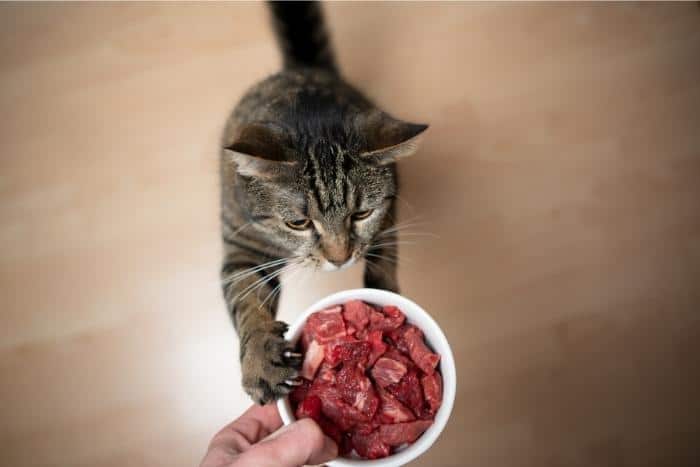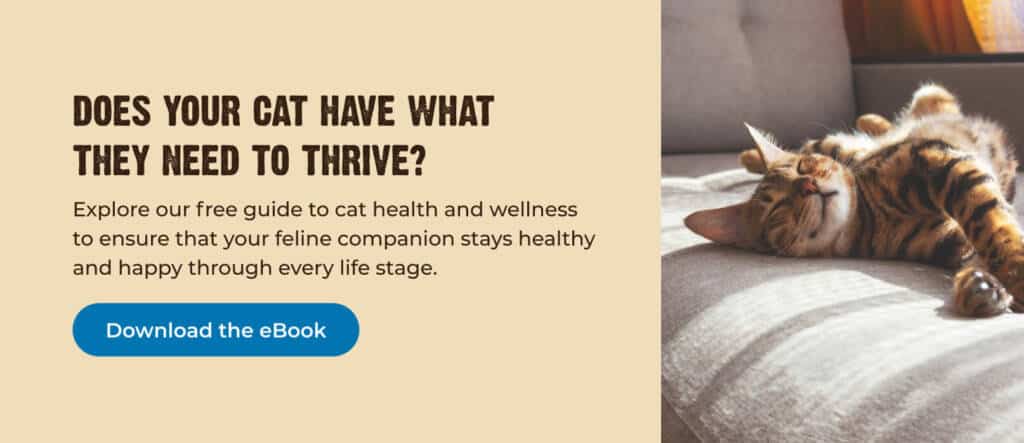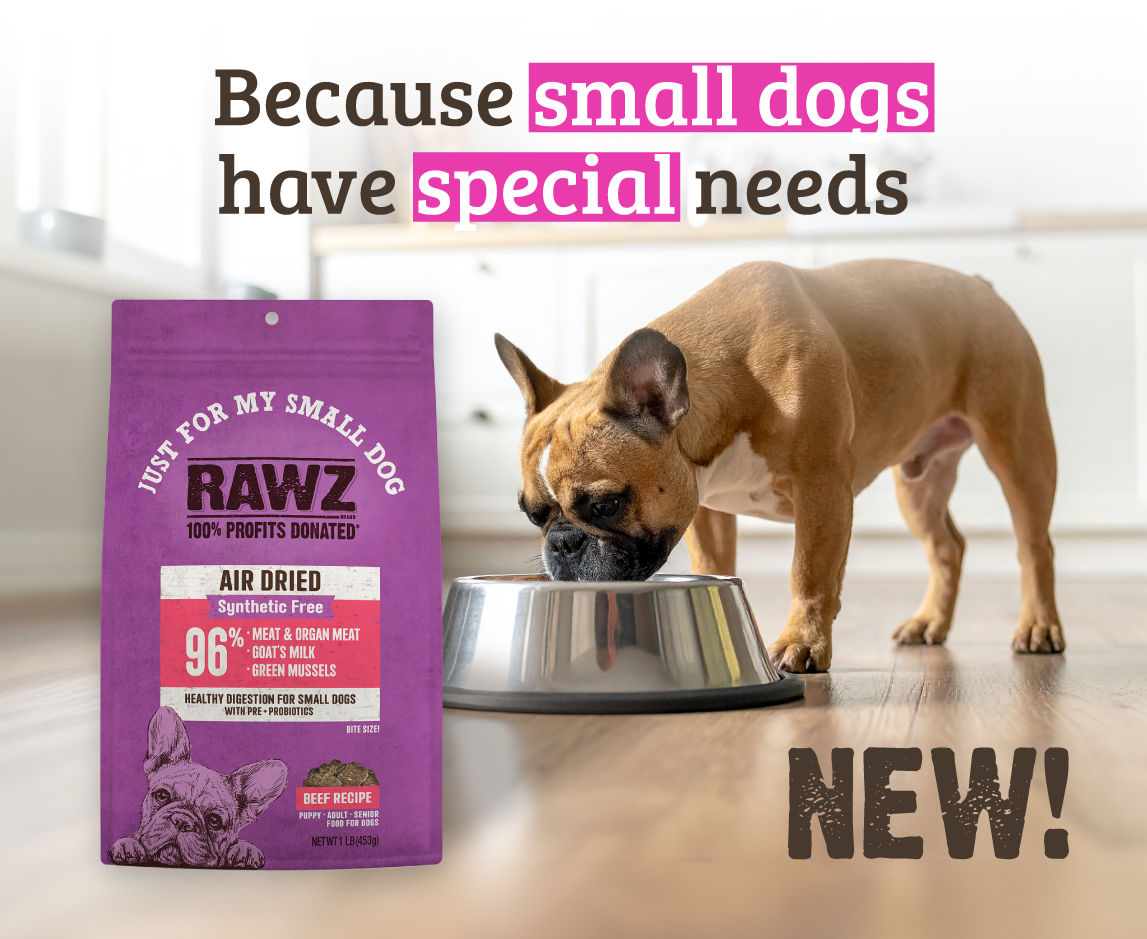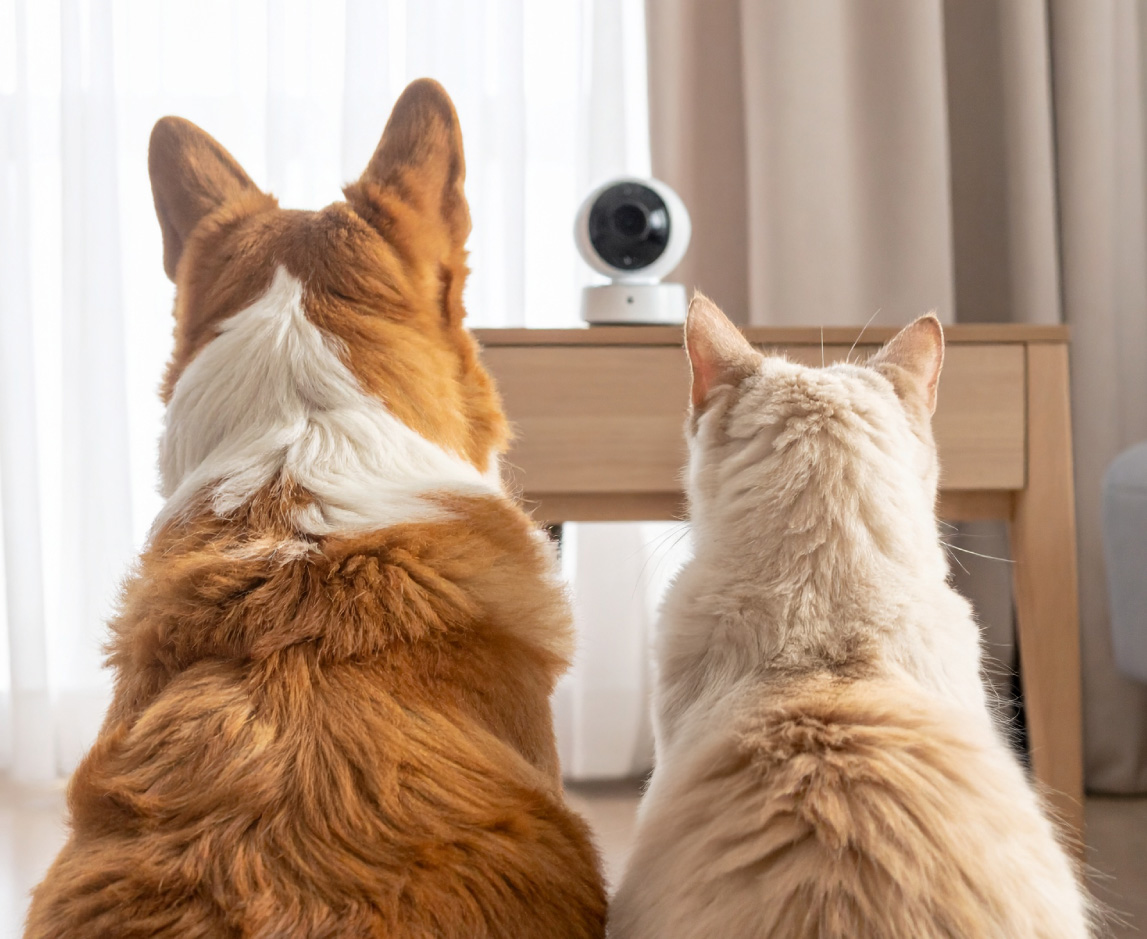The acronym may sound unappetizing, but a BARF diet for cats is an effective way to control what’s in their food while satisfying their intrinsic needs as obligate carnivores.
Read on for details:
What is a BARF Diet for Cats?
BARF stands for “biologically appropriate raw foods” or “bones and raw foods.” When it comes to pet food, “raw” is a broad term that can include many options. You can choose to make your own homemade raw cat food or purchase prepackaged raw meals that are made by pet food manufacturers and available in many pet stores. In the U.S., 3% of dog owners and 4% of cat owners purchase raw food for their pets.
A true BARF diet for cats includes much of what a feline in the wild would eat: muscle meat, bones and organs. Uncooked prey is high in protein and moisture, and contains essential substances that are only found in meat, such as taurine, fatty acids, vitamins and minerals. A BARF diet aims to resemble a wild diet as much as possible to provide cats with all of these essential nutrients.
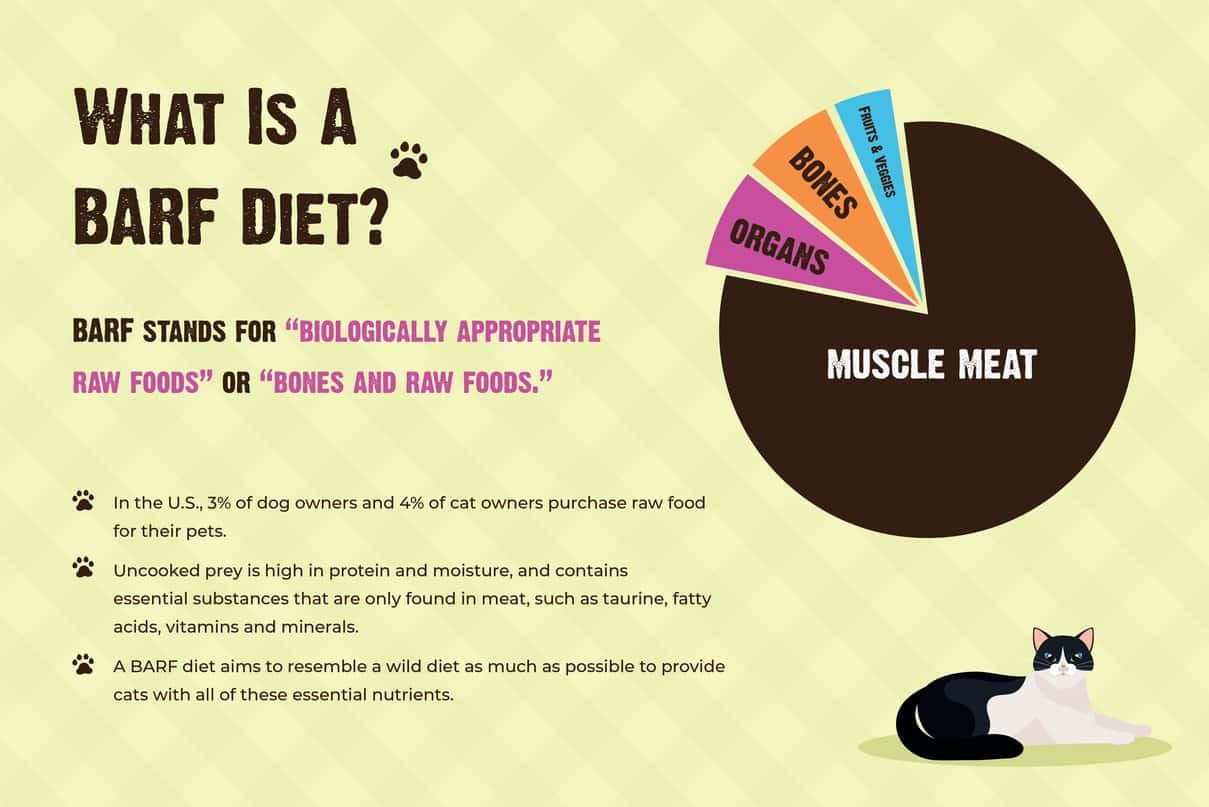
Is a BARF Diet for Cats Safe?
There are two primary concerns about the safety of BARF diets for cats: nutritional imbalances and bacterial contamination.
Nutritional Imbalances
The majority of prepackaged raw pet food options sold in pet stores are complete and balanced. All pet food for sale in the U.S. must have a nutritional adequacy or AAFCO statement on its packaging to show that it meets nutritional minimums, so you should look at the labels to verify that it is complete and balanced. If this is not listed on the packaging, there will be a statement advising that the food is intended for intermittent or supplemental feeding only.
Homemade raw meat is where there can be a risk. In the wild, cats consume nearly every part of their prey, which provides the appropriate amount of nutrients — bones provide calcium, organs provide taurine and meat provides protein and moisture. One of the biggest mistakes pet parents make when switching to a BARF diet is not understanding how to prepare complete and balanced raw food. Homemade BARF diets need to mimic the diet of a cat in the wild as closely as possible. That means incorporating the right amounts of organs, bones, vitamins and supplements. An incomplete or unbalanced raw diet can cause nutritional deficiencies that can lead to a variety of health issues.
Bacterial Contamination
Homemade raw diets, if not prepared correctly, can pose more of a bacterial health risk than prepared raw foods if the proper handling and cleaning procedures are not followed.
Manufacturers of prepared raw foods that you can buy from a pet store follow a zero-tolerance policy when it comes to bacteria and pathogens. Some manufacturers use FDA-approved high-pressure processing (HPP) to remove harmful bacteria, while others use elevated safety measures and testing procedures to ensure that it is free of pathogens.
The Benefits of a BARF Diet for Cats
Cats are obligate carnivores, which means that their bodies require nutrients that are only found in meat. Raw diets that are inspired by what a cat would eat in the wild can provide the nutrition, protein and hydration they need to live a healthy life.
The Feline Nutrition Foundation lists the following as the most noticeable benefits of a BARF diet for cats:
- Better digestion
- Less stool odor and volume
- Healthier coats (less shedding and fewer hairballs)
- Increased energy
- Improved urinary health
- Better weight control
- Improved dental health
The lack of heat processing in a raw diet offers better quality and higher levels of proteins and nutrients. Hydration levels are also greatly improved with a raw diet. Unlike dogs, cats do not have a natural thirst drive because their bodies are designed to get moisture from their prey — this is why many modern cats develop kidney and urinary issues. Since raw meat is devoid of heat processing, much of the moisture remains, which promotes urinary health and can help the kidneys process waste more efficiently.
How to Prepare a BARF Diet for Cats
Preparing a homemade BARF diet for your cat can be a complicated process when you’re first getting started. However, once you know how to safely prepare the raw food, it will just take some practice.
First, you must make sure that you have the right ingredients to create a complete and balanced raw diet for your cat. It can be challenging to make the switch from purchasing pet food at the store to preparing it all in your kitchen. Education is key here because you need to ensure that your cat is getting all of the proper nutrients for a complete and balanced diet. Homemade raw diets include the following ingredients:
- Meat
- Organs
- Bone
- Fat
- Egg yolks
- Water
- Supplements (Taurine, vitamin E, vitamin B complex, fish oil, etc.)
The Feline Nutrition Foundation and CatInfo.org offer recipes and step-by-step instructions for preparing a BARF diet. You may also want to consider supplementing your homemade raw food with complete and balanced prepared raw food, dry food or wet canned food from a pet store.
Second, proper handling, serving and storage of the food is an absolute must. Since you’re using raw ingredients, there is the potential for cross-contamination of bacteria to humans if the correct steps are not taken. The CDC encourages pet owners to follow these guidelines when preparing a homemade BARF diet for cats:
- Always wash your hands with soap and water before and after handling raw food.
- Keep the raw food out of reach from children.
- Properly store all raw food and ingredients away from human food.
- Use a designated scooper and bowl for the raw food, and clean it thoroughly in between uses.
- Clean and disinfect all areas that the food may have touched.
Transitioning from taking a few seconds to open a new can of wet food to spending time in the kitchen carefully preparing your cat’s raw food is definitely an adjustment. The potential for error is high, especially if you leave the food out for too long or make ingredient substitutions, as Dr. Rebecca Remillard DVM tells Fetch by WebMD. However, Dr. Remillard also says that homemade raw diets can work “as long as cat owners consult a veterinarian-nutritionist to formulate one.”
RELATED READING: WHAT'S IN THEIR BOWL? HERE'S HOW TO READ & DECODE A PET FOOD LABEL. >
What Do the Vets have to say about it?
Surprisingly, veterinarians receive very little nutritional instruction in their general course load. “What they do get is mostly taught by employees of the larger pet-food companies,” says Kymythy R. Schultze, Clinical Nutritionist and Animal health Instructor. “Unless they’ve taken it upon themselves to study animal nutrition in an unbiased forum, they may not be the best source of advice for species-appropriate food for my cats.” This is, of course, in reference to vets who aren’t certified animal nutritionists — so if your vet does not have this additional training, it’s best to seek a second opinion on a BARF diet from someone who does.
But dedicated veterinarian-nutritionists can attest to the benefits of incorporating raw foods into your cat’s diet, especially when it comes to chronic illness. “I have seen diabetes, asthma, lower urinary tract (bladder) problems, chronic vomiting and/or diarrhea, skin and ear problems and other health issues either markedly improve or completely resolve when raw diets were introduced,” says Andrea Tasi, VMD, who works exclusively with felines. “Every cat will respond in their own way, but I now view real, fresh, raw food as the ‘best medicine’ for many of my patients.” However, Dr. Tasi cautions against feeding raw meat to cats with weakened immune systems or those on chemotherapy or cortisone-type drugs. These cats can still benefit from a minimally processed or homemade cooked diet.
“Most people who are concerned about their own nutrition have heard nutritionists say ‘shop the perimeter of the grocery store,’” says Lisa A. Pierson, DVM. “This statement refers to the push to get humans to focus on fresh food — not overly processed food found in boxes and cans.” Dr. Pierson encourages people to shop the same way for their cats, although cat parents won’t find birds, mice or any other “wild” cat food in the grocery store. But to her point, the middle aisles won’t provide much in the way of fresh feline nutrition.
For those concerned about the cost of a raw or homemade diet, there is good news. Since a raw diet is naturally higher in moisture, protein and nutrients — and therefore more filling — your cat won’t need to overindulge to reap the benefits. Plus, there are ways to cut down on prep time. “Feeding whole parts such as chicken wings, necks or gizzards is an easy addition to their diet and provides chewing exercise,” says Margaret Gates, founder of the Feline Nutrition Foundation. “Buying pre-ground meat/bone/organ mixes” — instead of grinding the meat yourself — “and adding your own supplements can substantially lower your costs. It's also very easy.”
When it comes to food safety, the experts say there’s little to worry about. “While [bacterial contamination] is certainly a possibility, just as food poisoning of humans who eat raw meat is always at least a possibility, the reality is highly controllable and overstated,” writes Elizabeth Hodgkins, DVM, in her book Your Cat: Simple New Secrets to a Longer, Stronger Life. “Human-grade ground and whole raw meats for pets are available today because of the growing popularity of the practice among pet owners.”
If preparing entirely raw meals daily for your cat is not sustainable or convenient, you can mix raw ingredients in with minimally processed selections to give your cat the well-balanced diet they need. High quality, minimally processed wet and dry foods can offer similar nutrition to raw foods in a more convenient form, so you know your cat is getting the same proteins and nutrients you are.
FAQs About BARF Diets for Cats
Q: Is a BARF diet complete and balanced?
A: Most prepackaged, prepared raw foods that are available in pet stores are complete and balanced. If you are preparing a homemade BARF diet, you will need to include a vitamin pack or nutritional supplements to make sure that you are offering your cat a fully balanced meal.
Q: How do I transition my cat to a raw diet?
A: Most cats do well with a slow transition that relies on less processed foods over time. You can try phasing in raw food slowly, but there are many factors that may affect how your cat responds. View the Feline Nutrition Foundation’s transitioning guide for helpful information.
Q: Are there comparable alternatives to a BARF diet for cats?
A: Yes. There are freeze-dried and dehydrated foods that do not include heat-processed ingredients, while others aim to minimize the impact of heat on nutritional value.
At RAWZ, we are advocates of raw feeding, but we also understand the concerns pet parents may have about food safety. That’s why we spent years working with veterinary nutritionists to develop raw-inspired, minimally processed cat food options that can be offered as your cat’s main food source or as a supplement to a BARF diet. Our recipes are naturally preserved and are free of highly processed meals, gums and fillers.
For more information about raw diets for cats, check out these articles:
Homemade Cat Food: Benefits, Tips & How to Get Started
Why Your Cat is an Obligate Carnivore
Should You Feed Your Cat a Raw Diet? 11 Questions to Ask First


